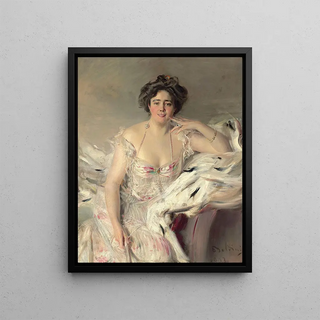Art print | Portrait of Lady Nanne Schrader and Wiborg - Giovanni Boldini


View from behind

Frame (optional)
In the fascinating world of painting, some artworks manage to transcend the simple frame of art to become true testimonies of an era. The "Portrait of Lady Nanne Schrader et Wiborg" by Giovanni Boldini is a shining example. This painting, created at the end of the 19th century, captures not only the beauty of its model but also the essence of a society in full transformation. Boldini, master of the art print, manages to infuse a vibrant life into his subjects, making each piece unique and timeless. The fascination this art print evokes lies in its ability to combine elegance and dynamism, offering the viewer a glimpse of a time when fashion and culture intertwined with unmatched grace.
Style and uniqueness of the work
Giovanni Boldini's style is often associated with an impressionist approach, tinged with touches of realism. In the "Portrait of Lady Nanne Schrader et Wiborg," there is an exceptional mastery of colors and textures. Lady Wiborg's sumptuous clothing seems almost tangible, with every fold and nuance of fabric rendered with remarkable precision. Boldini excels in capturing light, which dances across the protagonist's dress, creating a play of shadows and reflections. This art print does not merely depict a female figure; it tells a story, that of a strong and charismatic woman evolving in an aristocratic environment. Lady Wiborg's posture, both graceful and confident, reflects her social status while revealing a dynamic personality. Boldini succeeds in immortalizing the moment, while hinting at the emotions that animate his model.
The artist and his influence
Giovanni Boldini, born in Italy in 1842, established himself as one of the most prominent portraitists of his time. His artistic journey led him to Paris, where he mingled with the great names of art and absorbed the artistic currents of his era. Boldini managed to fuse the influence of romanticism with the beginnings of modernism, creating a style that is uniquely his own. His work had a

Matte finish

View from behind

Frame (optional)
In the fascinating world of painting, some artworks manage to transcend the simple frame of art to become true testimonies of an era. The "Portrait of Lady Nanne Schrader et Wiborg" by Giovanni Boldini is a shining example. This painting, created at the end of the 19th century, captures not only the beauty of its model but also the essence of a society in full transformation. Boldini, master of the art print, manages to infuse a vibrant life into his subjects, making each piece unique and timeless. The fascination this art print evokes lies in its ability to combine elegance and dynamism, offering the viewer a glimpse of a time when fashion and culture intertwined with unmatched grace.
Style and uniqueness of the work
Giovanni Boldini's style is often associated with an impressionist approach, tinged with touches of realism. In the "Portrait of Lady Nanne Schrader et Wiborg," there is an exceptional mastery of colors and textures. Lady Wiborg's sumptuous clothing seems almost tangible, with every fold and nuance of fabric rendered with remarkable precision. Boldini excels in capturing light, which dances across the protagonist's dress, creating a play of shadows and reflections. This art print does not merely depict a female figure; it tells a story, that of a strong and charismatic woman evolving in an aristocratic environment. Lady Wiborg's posture, both graceful and confident, reflects her social status while revealing a dynamic personality. Boldini succeeds in immortalizing the moment, while hinting at the emotions that animate his model.
The artist and his influence
Giovanni Boldini, born in Italy in 1842, established himself as one of the most prominent portraitists of his time. His artistic journey led him to Paris, where he mingled with the great names of art and absorbed the artistic currents of his era. Boldini managed to fuse the influence of romanticism with the beginnings of modernism, creating a style that is uniquely his own. His work had a






